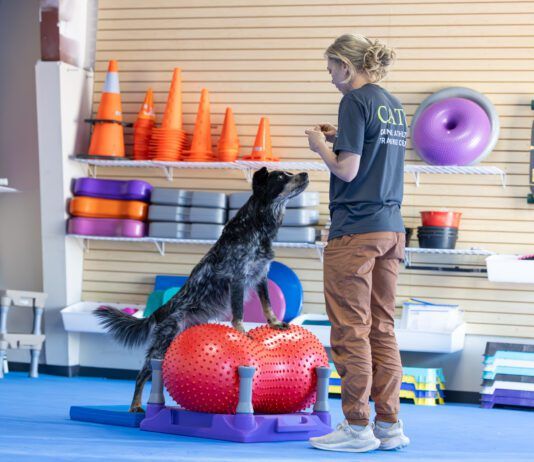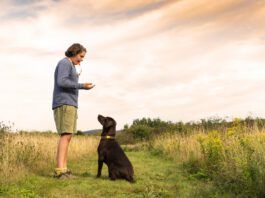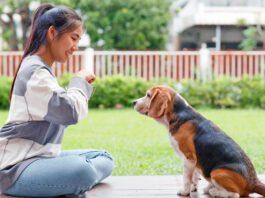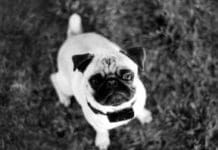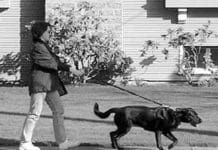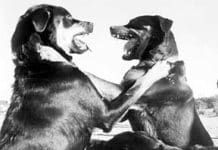Training Your Dog to Use His Nose With Positive Reinforcement
One of the cool things about dogs is the variety of tasks, tricks, and trades they can learn. Dogs perform lifesaving work in search and rescue and criminal justice venues, and they are employed to detect everything from prohibited fruits, vegetables and meats in airports to termites in homes. These abilities are directly related to their sense of smell. All dogs have a highly developed sense of smell, although some breeds – primarily scenthounds and sporting dogs – show greater ability than others.
Training a Dog to Stay Using Cues
Sandi chooses a
quiet location. Blue is easily distracted, so
she works at a close range and slowly builds
the duration of the Stay.üWhen a cyclist pulled up, Sandi moved right
next to Blue to ascertain how he would deal
with a distraction.
quiet location. Blue is easily distracted, so
she works at a close range and slowly builds
the duration of the Stay.üWhen a cyclist pulled up, Sandi moved right
next to Blue to ascertain how he would deal
with a distraction.
Tug o War Used As a Training Tool
From tiny Pomeranians to huge Mastiffs, dogs love to play Tug o War. There is an inherent canine joy in growling, grabbing, pulling, shaking, ripping and shredding that satisfies a dog's basic predatory instincts. Owners also find it rewarding to roughhouse with their four-footed friends, and a Tug o War game is a great way to take the edge off a high-energy pooch. Many trainers caution against playing Tug o War with canine companions, warning that it teaches a dog to be dominant and aggressive. I encourage my students to play Tug o War with their dogs.
Canine Counselor
says Frost. This unconditional acceptance that dogs extend to us is one of the nicest perks that this special relationship offers us.
Another benefit we gain from our dogs is a sense of expansiveness and ease. People tend to be more open around animals, and dogs in particular. Frost notes, We are often more open
Shocked About E-Collars
I suggest they wear one and let you "tune" the intensity until it reaches their "recognition" level. I have two dogs who
Tethering Your Dog for Training
For many years, I have been a vigorous and vocal opponent of keeping dogs tied or chained as a primary means of confinement. The hazards of tying a dog are well-documented, and include increased aggression, vulerability to human and non-human intruders, and the risk of hanging or choking. It may come as a surprise, therefore, to know that I regard the tether as an invaluable piece of training equipment. The difference and it's a big one is in the application.
Spring Into Better Health
Dogs that exercise regularly live longer, incur fewer veterinary bills, and are better behaved. Sit up and take action!
No Miracle Products
These "no-pull" products can help you train your dog, but they don’t work at all if they are misused.
Training Classes for Aggressive Dogs
dog owners are taught to recognize behavioral signs of impending aggression
Target-Train Your Dog to Ring A Doorbell
Each month, I stand in the middle of my training center during the second session of my newest Level One class and introduce my...
Crate Training Made Easy
The crate is a sturdy plastic, fiberglass, wood, metal or wire box just big enough for a dog to stand up, turn around and lie down in comfortably. It can be used with the door open, at your convenience, or with the door closed, when mandatory confinement is called for. When the crate is properly introduced using positive training methods, most dogs love their crates. Canines are den animals and a crate is a modern den a dog's personal portable bedroom that he can retire to when he wants to escape from the trials and tribulations of toddlers and other torments. He can take it with him when he stays at boarding kennels, and when he travels with you and sleeps in hotels and motels.
Portable Dog Crates are Invaluable Travelling Tools
The crate has long been proven to be an invaluable in-home dog behavior management tool. It is also extremely useful on the road. For a long time, the only downside of crates has been that they are big, heavy, and awkward to lug around. A crate big enough for a Labrador Retriever, Rottweiler or (imagine) Great Dane won't even fit in most cars which is one reason why a lot of big-dog owners drive vans and SUVs!


